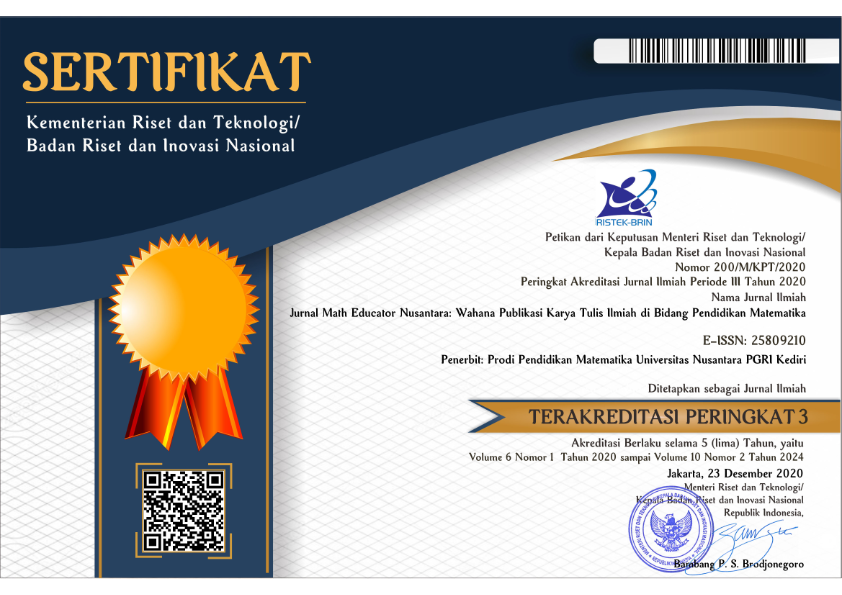Integration of digital literacy in didactic design: Prospective analysis on algebra learning
DOI:
https://doi.org/10.29407/jmen.v8i1.16355Keywords:
didactical design research, hyphotetical learning trajectory, internet, linier equationAbstract
This study aimed to formulate the Hypothetical Learning Trajectory (HLT) as part of the Didactical Design Research at the prospective analysis stage in the VIII class of Algebra learning, namely the Two-variable Linear Equation System (TVLES). HLT is based on a study of learning obstacles which includes aspects of repersonalization of material content, potential use of digital media in learning, curriculum analysis, and didactic aspects and is adapted to the needs of students and the development of digital literacy. This study involved 47 students of class VIII, 21 students of class IX, 3 mathematics teachers, and 5 model students. Based on a prospective analysis, the HLT on aspects of the TVLES concept is formulated as follows: 1) Considering the concept of “The Meaning of the Equal Sign” through an open context (realtime thinking literacy), recognize variables as unknown values and varying quantities; 2) Completing an open sentence using trial and error through the context of scales (photo visual literacy); 3) revealing the relationship between symbolic representations and straight-line graphs; the meaning of the point of intersection, using algebraic concepts in completing TVLES (branching literacy); 4) create a mathematical model of a problem related to TVLES (information literacy), and; 5) solving various problems related to TVLES through a logical algorithm. This HLT was expected to be developed into a didactic design which will later be implemented in learning.
References
Adiarsi, G. R., Stellarosa, Y., & Silaban, M. W. (2015). Literasi Media Internet di Kalangan Mahasiswa. Humaniora , 470-482.
Amalia, S. (2017, Oktober 2). Literasi Lintas Mata Pelajaran Matematika. Retrieved 12 18, 2021, from Kompasiana: https://www.kompasiana.com/amelya1397/59d14035677ffb307772cb82/literasi-lintas-mata-pelajaran-matematika.
Ball, D. L., & Bass, H. (2003). Making mathematics reasonable in school. A research companion to principles and standards for school mathematics , 27-44.
Belshaw, D. A. (2020). What is Digital Literacy? A pragmatic Investigation. Retrieved from http://etheses.dur.ac.uk/3446/
Carpenter, T. P., Fanke, M. L., & Levi, L. (2003). Thinking mathematically. Portsmouth, NH: Heinemann.
Frydenberg, M., & Adone, D. (2011). Learning for 21st century skills. In International Conference on Information Society (i-Society 2011) (pp. 314-318). London: IEEE.
Fuadiah, N. F., Suryadi, D., & Turmudi, T. (2018). Teaching and learning activities in classroom and their impact on student misunderstanding: a case study on negative integers. International Journal of Instruction , 407-424.
Hartono, J. A., & Karnasi, I. (2017). Pentingnya pemodelan matematis dalam pembelajaran matematika . Prosiding Seminar Nasional Matematika (SEMNASTIKA) 2017. Medan: Unimed.
Islamiah, A. C., Prayitno, S., & Amrullah, A. (2018). Analisis kesalahan siswa SMP pada penyelesaian masalah sistem persamaan linear dua variabel. Jurnal Didaktik Matematika , 66-76.
Jones, R. H., & Hafner, C. A. (2012). Understanding Digital Literacies: A Practical Introduction. Routledge.
Jufri, A., & Drijvers, P. (2016). Student difficulties in mathematizing word problems in algebra. Eurasia Journal of Mathematics, Science and Technology Education , 2481-2502.
Kaput, J. J. (1999). Teaching dan learning a new algebra. In E Fennema & T.A Romberg. Marwah: Mathematic Clashrooms tahat Promote Understanding. NJ:Erlbaum.
Kemendikbud. (2017). Materi Pendukung Literasi Digital. Jakarta: Kemendikbud.
Khikmiah, F., & Midjan, M. (2017). Pengembangan buku ajar literasi matematika untuk pembelajaran di SMP. Jurnal Silogisme: Kajian Ilmu Matematika dan Pembelajarannya , 15-26.
Mawarni, J., Syahbana, A., & Septiati, E. (2019). Pengaruh strategi pembelajaran REACT terhadap kemampuan berpikir kritis ditinjau dari kemampuan awal siswa SMP. Indiktika: Jurnal Inovasi Pendidikan Matematika , 172-180.
Mujulifah, F., Sugiatno, & Hamdani. (2015). Literasi matematis siswa dalam menyederhanakan ekspresi aljabar. Jurnal Pendidikan dan Pembelajaran , 12.
Ningsih, Y. L., Misdalinah, M., & Marhamah, M. (2017). Peningkatan hasil belajar dan kemandirian belajar metode statistika melalui pembelajaran blended learning. Al-Jabar: Jurnal Pendidikan Matematika , 155-164.
OECD. (2018). PISA 2018 Results Combined Executive SummariesVolume I, II & III. OECD.
OECD. (2015). Programme for International Student Assessment Result for PISA 2015; PISA-2015-Indonesia. OECD .
Pangaribuan, F. (2018). Students’ abstraction in solving system of linear equations with two variables. In Journal of Physics: Conference Series , IOP Publishing.
Rahayuningsih, P., & Qohar, A. (2014). Analisis kesalahan menyelesaikan soal cerita Sistem Persamaan Linear Dua Variabel (TVLES) dan Scaffolding-nya berdasarkan analisis kesalahan Newman pada siswa kelas VIII SMP Negeri 2 Malang. Jurnal Pendidikan Matematika dan Sains , 109-116.
Ricoibah, D. I., & Pibriana, D. (2016). Pengaruh penggunaan internet terhadap minat dan perilaku belajar mahasiswa. SESINDO 2016. SESINDO 2016 (pp. 281-288). Surabaya: Departemen Sistem Informasi, Institut Teknologi Sepuluh Nopember.
Schifter, D. (1999). Reasoning about operations: Early algebraic thinking, grades K through 6. In I. S. Curcio, Developing Mathematical Reasoning in Grade K-12.
Schifter, D., Monk, S., Russel, S. J., & Bastable, V. (2017). Early algebra: What does understanding the laws of arithmetic mean in the elementary grades? In Algebra in the early grades. Routledge.
Selber, S. A. (2004). Multiliteracies for a Digital Age. IEEE. Transactions On Professional Communication.
Setyaningsih, R., Abdullah, A., Prihantono, E., & Hustinawaty, H. (2019). Model penguatan literasi digital melalui pemanfaatan e-learning. Jurnal ASPIKOM , 1200-1214.
Srinadi, N. L. (2015). Analisis pengaruh penggunaan teknologi informasi sebagai media pembelajaran terhadap motivasi belajar siswa. Proceedings Konferensi Nasional Sistem dan Informatika (KNS&I) (pp. 891-895). Bali: STMIK STIKOM.
Sugihartati, R. (2020). Literasi Digital Harus Terintegrasi dengan Mata Pelajaran. Jakarta: Media Indonesia.
Suryadi, D. (2016). Didactical Design Research: Upaya membangun kemandirian berpikir melalui penelitian pembelajaran. Bandung, Indonesia: Rizqi Press. In D. Suryadi, Monograf Didactical Design Research. Bandung, Indonesia: Rizqi Press.
Suryadi, D. (2019). Penelitian Desain Didaktis dan Implementasinya. Bandung: Gapura Press.
Susanti, M., Hasinah, A. N., & Zanthy, L. S. (2020). Analysis of mathematical communication skills students for two variable linear equation systems material. MEJ (Mathematics Education Journal) , 1-6.
Turner, R. (2016). Lessons from PISA 2012 about Mathematical Literacy: An Illustrated Essay. PNA. Granada, Spanyol: Universidad De Granada.
Wijaya, E. Y., Sudjimat, D. A., & Nyoto, A. (2016). Transformasi pendidikan abad 21 sebagai tuntutan pengembangan sumber daya manusia di era global. Prosiding Seminar Nasional Pendidikan Matematika (pp. 263-278). Malang: Universitas PGRI Kanjuruhan Malang.
Downloads
Published
Issue
Section
License
Authors who publish with this journal agree to the following terms:
- Copyright on any article is retained by the author(s).
- The author grants the journal, the right of first publication with the work simultaneously licensed under a Creative Commons Attribution License that allows others to share the work with an acknowledgment of the work’s authorship and initial publication in this journal.
- Authors are able to enter into separate, additional contractual arrangements for the non-exclusive distribution of the journal’s published version of the work (e.g., post it to an institutional repository or publish it in a book), with an acknowledgment of its initial publication in this journal.
- Authors are permitted and encouraged to post their work online (e.g., in institutional repositories or on their website) prior to and during the submission process, as it can lead to productive exchanges, as well as earlier and greater citation of published work.
- The article and any associated published material is distributed under the Creative Commons Attribution-ShareAlike 4.0 International License














